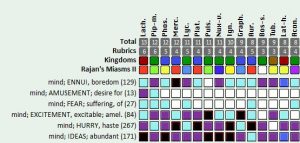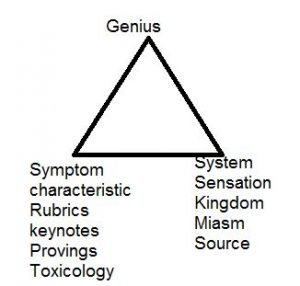Introduction
Edited By: the other song Publications Team
Case by Dr. Rajan Sankaran
The following is an introductory article of a series on Studying The Plant Kingdom with the other song: International Academy of Advanced Homeopathy. Here, we will look at the basic understanding of the Plant Kingdom, along with a case example and personal words of discovery from Dr. Sankaran. In consecutive months, we will study each family in detail along with a case example.
The basic issue of plant families is sensitivity and reactivity. In the human being, the Plant experience is that of sensitivity. They are affected by many things and must adapt and adjust to them.The plant individual gets easily affected and describes that as something is happening within him.
Let’s look at a small example: a mineral person giving a history of a headache will probably start as “My first attack of headache started on a certain date and time”. This is a structured talk. A person needing an animal remedy would say, “This headache is after me. It has been after me for a long time and now I have to get rid of it once and for all”. A plant person would say, “This headache really affects me, hurts me and causes me to weep”. This is plant sensitivity and reactivity. They are emotional, sentimental and usually disorganized.
The common sensation of the family:
If the main thing in the plant kingdom is sensitivity, then each family must have its own kind of sensitivity. Remedies from a particular family share at least one common sensation or type of pain.
As an example, remedies of the Composite family share the sensation of being injured or hurt. This common sensation expresses itself in all remedies of the family, in differing ways. Some like Arnica express the sensation directly as a bruised pain; yet others likes Chamomilla express it as a reaction by hurting others. But the main feeling in all of them remains common.
The sensation could be expressed in four different ways viz. as the sensation itself, as a passive reaction, as an active reaction, or as compensation. For example if the sensation is being injured or hurt, the passive reaction is to get dazed, the active reaction is to strike back and the compensation is to become the tough one who can take any hurt. On closer examination we realize that all the remedies of a given family have all these types of expressions, though one type is better known in each specific remedy.
How each remedy in a family differs:
Despite the common feeling or sensation, there is a wide difference in the pictures or symptomatology of the various remedies in the same family. This difference is because they belong to different miasms. In other words, this means that though the sensation is common, each remedy perceives it in a different depth and degree of desperation, and this accounts for the difference in the symptoms.
In asking the question, what is common in Nux-v, Gels and Ign., we see that:
- Nux is a bossy, fastidious, impatient, irritable person.
- Gels is a nervous, tremulous, sleepy, drowsy person who cannot take bad news.
- Ign is a woman who has had a big grief, disappointment or shock and has to hold everything within herself (Silent grief).
Although the three remedies have different expressions they share a common sensation i.e. “Shock- How can this happen!” The difference is that each remedy perceives the shock in a different degree. Though the common sensation is shock, each remedy has its own pace, depth and degree of desperation i.e. the common sensation is experienced in a different way by each of the remedies.
Nux-v feels “How can I recover from this quickly? (Impatient) The stock market has fallen and I must recover quickly.”
Gels has the feeling “I cannot withstand the shock, I am too weak and must avoid anything that causes the shock” In anticipation of the shock he becomes tremulous, gets an urge to go to the toilet or becomes sleepy. If asked to give a speech on the spur of the moment he avoids it.
Ign. perceives that she cannot avoid the shock and must be in control of herself in the face of shock. e.g. A woman with children suddenly learns about the death of her husband. Her life is changed from total order to chaos. She needs to hold the grief within herself and be in total control.
Nux perceives it as a critical situation (typhoid), Gels needs to avoid (sycotic) and Ign perceives as chaos and needs to be in control (cancer). The three remedies perceive the situation of shock in different ways. . So we understand that a particular family has a particular sensation that is common to all the remedies of the family and each remedy in that family perceives it in a different way, which is the miasm.
In this series from TOS,
Discovering the Plant Kingdom
Words from Dr. Sankaran
Using the Botanical system of classification, I started to study remedies in groups according to their families with a purpose to find the common features between each of them. Initially, there was a lot of difficulty. For example, the family Ranunculaceae which includes such as Aconitum napellus, Pulsatilla pratensis and Staphysagria: on the first glance the intense fear of death that marks the Aconitum napellus state seems to have to do nothing with either the mildness or the weeping nature of Pulsatilla or the indignation of Staphysagria.
But then, I understood that the main issue in the plant kingdom is sensitivity. They are affected by physical and chemical changes in their environment. Sound, light, chemical substances and various other stimuli have an effect on the growth of plants. A plant remedy has an intense sensitivity to certain stimuli and situations. Those situations or stimuli affect him, producing within him a sensation which is specific to the plant family he belongs to. Therefore, what you will see in the plant remedies will be a prominence of the sensation, a particular sensation in a given family and its opposite.
So I was faced with a question where I could find the sensitivity best expressed in the symptomatology. The answer is in the sensations, in the type of pain, in the sensation of the pain etc. So I searched the Repertory using a software program, MacRepertory and the Reference Works, and to my utter joy, I found that remedies from a particular family shared at least one common sensation or type of pain. For example, you know very well that the remedies of the Compositae family share the sensation of “injury or hurt”; e.g. Arnica montana expresses this sensation directly as a ‘bruised pain’, yet Chamomilla experiences the same as a reaction by causing pain or hurt to others.3
So a Plant remedy or a person functions along one axis of experience. Almost every one of their experiences in life can be brought down to that sensation and its opposite.
For this, I used MacRepertory created by my friend David Warkentin, since it has a good search function across a large number of standard books, but I believe any good software with that function would serve the same purpose. I used the program to search the whole repertory and list those rubrics that had any two, or in some cases any three or four remedies in a plant group, limiting the list to only those rubrics that contain fifty remedies. This would include rubrics from every chapter of the repertory, including Mind, Generalities, and the different regions.
Once this list was obtained, I commanded the program to arrange this rubric list according to the number of remedies in the rubric, starting with the least number of remedies. Going down the list, I would look for a sensation or a feeling that would be a possible common factor in the remedies of that family. I would look for sensations, especially those I had not heard of in other families and those which, (with my knowledge of some of the remedies of that family) I could co-relate and connect with the remedies. This would occasionally help me to zoom in on the characteristic sensation of the family.
Once I had come to a possible common sensation of that family, the next step was to test it out in each individual member of the family, starting with the better known ones. I used, primarily, Phatak’s Materia Medica or the book of Repertory extractions, which are part of material medica programs. I tried to be as objective as possible in this study. One of the yardsticks I used was to see if the most characteristic symptoms of the remedy being studied had the family sensation directly or indirectly. The second confirmation I sought was to see if the Mind picture of the remedies of the given family had a reflection of the general sensation that I had hypothesized. If I did not find enough proof, so I had to go back to the list to make a different search by including other remedies of that family.
Once I was convinced about the main sensation of the family, I again studied each remedy of that family to perceive the different forms and descriptions of that sensation both physically and emotionally. This study made the whole picture clearer and sharper. I thus found that the sensation can occur in a given remedy in a direct form, as a passive reaction, an active reaction or as compensation. Each remedy was studied in detail to identify these different states, which helped complete the picture of the common family sensation.
A Case Example:
(Notes in italics comprise my understanding)
I saw a middle-aged lady a year ago who had to wait for sometime before I could see her. The lady threw a ruckus saying that she couldn’t wait any longer for the doctor.
The beginning itself was significant and I observed that her impatience was peculiar, and I quickly inferred that discovering the pattern of this impatience – cause and its character would be the main theme of this case. It is like flowing along a river, you have both the right and the left banks. On one side, on a bank, you have a language which is rich in rubrics, direct symptoms; while on the other you have observations and perception when the patient is in front of you, which when correctly observed without any interpretations on our part can form important symptoms. Both the sides often go hand in hand during the case and this observation about the patient’s impatience was an important insight into the case. (for further reference – Synergy in Homoeopathy, chapter -System and Symptoms by Dr. Rajan Sankaran)
During the case interview, the patient said that she was diagnosed with premature ovarian failure which was asymptomatic at first and later presented with panic attacks and nervousness. Hormone replacement therapy and homoeopathic treatment from other doctors failed to help her. She also had tinnitus. Also the complaints were slowly progressive and it was something which she had accepted as a part of her life.
Here, we see that the pace of the complaint and the perception of the disease as a distress were not that intense or life threatening but something which was just slow and accepted. So this clarified the miasm as being sycotic.4
As the case progressed, it was apparent that she was an anxious person, with a fast pace and many ideas, who couldn’t sit idle and often feared suffering or getting ill with an incurable disease. She had a lot of fear of suffering. She could not sit idle, would get bored when she was free. She liked watching TV, desired amusement. She had a great liking for vibrant colours as she felt that they were full of energy. She would feel buzzed and energized on seeing them. On the other hand, when she saw dull colours, it would make her sad, dull and morose. She is a very active person and has many ideas about her work, and has an active imagination too.
Again we see the polarities of ‘buzzing / happening vs dull/ sad/boring. This sensitivity and its opposite reaction is typical of the plant kingdom. These polarities are the main experience of the family Piperaceae.5 (When the deepest experience is explored in patients who need plant remedies, they generally give a sensation which is very characteristic to that plant family or the opposite of this sensation using various words. The family Piperaceae has the following sensation as its main experience – Pain, no excitement and boredom. Boredom also means monotonous, unexciting, bland, tasteless, insipid etc. Ennui. Opposite: Amusement, Pleasurable. Reference – Insight into Plants – by Dr. RajanSankaran)
Also this is only one angle to the totality as every patient generally gives symptoms, the experience and the pace of the complaints, and all of them come together to the centre to a meeting point which is the remedy. Now for looking at the case from the symptom perspective, we have to look into our reference books and see what comes up. On putting her main complaint of anxiety at climacteric period, which through Reference Works is as follows:
Anxiety within four words of menopause/climateric (15): 3Aml-n., 2tril., acon., adam., androc., ars., aur., cimic., glon., kali-br., lach., pip-m., puls., sep., sil.6
We here see that Pip-m is one of the 15 remedies coming up in the reference works. On considering other rubrics, we get:
- Ennui > entertainment
- Amusement >
- Fear of suffering
- Amusement desire for
- Excitement amel
- Hurry, haste
- Ideas abundant
Again the remedy Piper-m is prominent through Repertorisation. Here, in this case, we see the symptoms on one hand and the system on the other hand both coming together, to form a synergy. This forms almost a confirmatory base for prescription. This coming together of the old and the new approaches is termed ‘Synergy’. This combination of one plus one is like a thousand; when these two come together, the fire is lit and the result is Synergy. The Sensation Approach gave a definitive idea and a firm basis for prescription.
Piper methysticum, is used to create some buzz in food as we know. All the symptoms and the experience indeed come to one meeting point here. The problem only is about the pace. Piper methysticum belongs to the cancer miasm (as per Dr Sankaran’s concepts of the new miasms), whereas the miasm of the patient was more sycotic. So the remedy Piper nigricum, belonging to the same family, but with sycotic miasm was given. It is also known that Piper nigrum which is Kava kava is used to alleviate anxiety during menopause, which was the presenting complaint of this patient. Within a few months all her complaints were much better, and she was off the hormonal therapy and she no longer had any panic attacks. This case was a beautiful illustration of an approach from the system to symptoms, and the ease that we come to the simillimum when we integrate the old and the new concepts.
The newer approaches have their roots in the old. The Synergy approach and the Sensation Approach in Homoeopathy provide a much needed integration and unification between the old schools of thought and the new. The advantages of this approach are that it is highly reproducible and provides homeopaths with a newfound confidence in their clinical practice. The integrative approach to cases leads to a more definite prescription in most cases.
Bibliography:
1 – RajanSankaran, An Introduction to the Levels, Sensation in Homoeopathy, Reprint 2009, Homoeopathic Medical Publishers, Mumbai.
2 – RajanSankaran, Vital Sensation and the Kingdoms, Sensation in Homoeopathy, Reprint 2009, Homoeopathic Medical Publishers, Mumbai
3 – RajanSankaran, An Insight into Plants, Volume 1, Introduction, Second Revised Edition, 2005, Homoeopathic Medical Publishers, Mumbai
4 – RajanSankaran, The Sensation in Homoeopathy, Miasms, Second Edition, 2005, Homoeopathic Medical Publishers, Mumbai
5 – RajanSankaran, An Insight into Plants, Volume 1, Introduction, Second Revised Edition, 2005, Homoeopathic Medical Publishers, Mumbai






